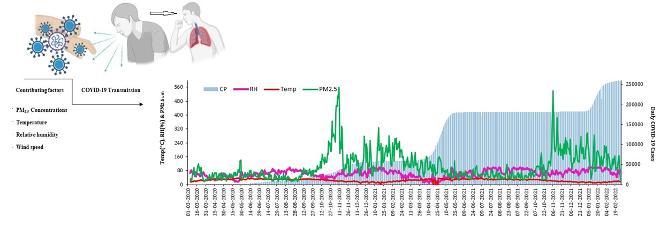COVID-19 transmission due to interplay between PM2.5 and weather conditions
Main Article Content
Abstract
Background: The association of air pollution with the COVID-19 pandemic majorly caused respiratory diseases among the major outcomes of COVID-19 infection. In addition, meteorological factors play an important role in spreading COVID-19 infection in humans who have been exposed to air pollutants.
Objectives: This study aims to estimate and comprehend the linkages between the contribution of PM 2.5 concentrations and meteorological parameters to the spreading coronavirus infection in Gurugram, a badly affected city in India due to the COVID-19 pandemic.
Materials and methods: We employed some statistical analysis on daily average data of PM 2.5 concentrations and meteorological conditions with daily COVID-19 cases from March 2020 to February 2022. To optimize PM2.5 concentrations linked with COVID-19 instances, a time series analysis was performed. The Pearson correlation test investigated the relationships between PM2.5levels, meteorological data, and COVID-19 instances. The PCA was applied to reveal the most significant factor attributable to affecting the rate of COVID-19 transmission in Gurugram.
Results: The highest cases of COVID-19 (250,000) were observed in February 2022 when PM 2.5 concentration was 286.6µg/m3, 12.64 oC temperature, 73.81% RH, and 68.265 km/h wind speed while minimum cases (3125) were found in March 2020 with the 18.18µg/m3 PM2.5 concentration, 10.62.oC temperature, 50.05% RH, and 83.295km/h wind speed.
Conclusion: The principal component analysis helped conclude the results, which revealed that the daily COVID-19 cases were significantly positively correlated with PM 2.5 concentrations, RH, and temperature. However, daily COVID-19 cases were negatively or poorly correlated with wind speed. COVID-19 pandemic is prominently affected by PM 2.5, while RH and temperature were found to be important meteorological factors significantly affecting its human-to-human transmission. This study may provide useful indications to regulatory bodies to modify environmental health policies.
Article Details

This work is licensed under a Creative Commons Attribution-NonCommercial-NoDerivatives 4.0 International License.
Personal views expressed by the contributors in their articles are not necessarily those of the Journal of Associated Medical Sciences, Faculty of Associated Medical Sciences, Chiang Mai University.
References
Satarker S, Nampoothiri M. Structural proteins in severe acute respiratory syndrome coronavirus 2. Arch Med Res. 2020; 51(3): 482-91. doi: 10.1016/j. arcmed.2020.05.012.
World Health Organization (WHO). Daily cases and deaths by date reported to WHO. 2023 [cited 2023 January 03]. Available from: https://covid19.who.int.
Malik YA. Properties of coronavirus and SARS-CoV-2. Malays J Pathol. 2020; 42(3): 5-11. PMID: 32342926.
Guruprasad L. Human coronavirus spike protein-host receptor recognition. Prog Biophys Mol Biol. 2021; 161(9): 39-53. doi: 10.1016/j.pbiomolbio.2020.10.006.
Choudhary A, Sreenivasulu K, Mitra P, Misra S, Sharma P. Role of genetic variants and gene expression in the susceptibility and severity of COVID-19. Ann Lab Med. 2021; 41(2): 129-38. doi:10.3343/alm.2021.41.2. 129.
Upadhyay E, Mohammad AA, Dasgupta N, Rahman S, Kim J, Datta M. Assessment of occupational health hazards due to particulate matter originated from spices. Int J Environ Res Public Health. 2019; 16(6): 15-9. doi: 10.3390/ijerph16091519.
Biswas, K. Chatterjee, A. Chakraborty, J. Comparison of air pollutants between Kolkata and Siliguri, India, and its relationship to temperature change. J Geovis Spat Anal. 2020; 4(7): 1-15. doi:10.1007/s41651- 020-00065-4.
Kumar A, Rana S. Population abundance of Greater Flamingo Phoenicopterus roseus (Aves: Phoenicopteridae) in district Gurugram of Haryana, India. J Threat Taxa. 2022; 14(7): 20821-7. doi:10.11609/ jott.2785.8.7.8953-8969.
Travaglio MY, Popovic R, Selley L, Leal NS, Martins LM. Links between air pollution and COVID-19 in England. Environ Poll. 2021; 268(2): 115855-9. doi: 10.1016/j.envpol.2020.115859.
Upadhyay E. An Introduction to Air Quality Index and Health Concerns. Bio Evolution. 2014; 1(4): 51-4. ISBN 978-81-925781-3-2.
Zoran MA, Savastru RS, Savastru DM, Tautan MN. Assessing the relationship between surface levels of PM 2.5 and PM10 particulate matter impact on COVID-19 in Milan, Italy. Sci Total Environ. 2020; 738: 139825. doi: 10.1016/j.scitotenv.2020.139825.
Anand V, Korhale N, Tikle S, Rawat MS, Beig G. Is Meteorology a factor to COVID-19 Spread in a Tropical Climate? Earth Syst Environ. 2021; 5(2): 939- 48. doi:10.1007/s41748-021-00253-2.
Climate & weather averages in Gurgaon, Haryana, India. [cited 2023 April 29]. Available from: www.timeanddate.com/weather/india/gurgaon/climate.
CPCB. Air quality monitoring, emission inventory and source apportionment study for Indian cities, New Delhi. 2022: 1-658. [cited 2022 December 12]. Available from: http://cpcb.nic.in/Delhi.pdf.
Health Bulletin District Gurugram for COVID-19. National Informatics Centre, Ministry of Electronics & Information Technology, Government of India. 2022. [cited 2022 April 29]: 1-702. Available from: https://gurugram.gov.in/health-bulletin.
Wang B, Li R, Lu Z, Huang Y. Does comorbidity increase the risk of patients with COVID-19: evidence from meta-analysis. Aging. 2020; 5(12): 60-49. doi: 10.18632/aging.103000.
Pati. City’s average AQI in November this year worse than last two years. 2022. [cited 2022 September 21]. Available from: http://timesofindia.indiatimes. com/articleshow/88017474.cms?utm_source=contentofinterest&utm_medium=text&utm_campaign= cppst.
Feng Y, Marchal T, Sperry T, Yi H. Influence of wind and relative humidity on the social distancing effectiveness to prevent COVID-19 airborne transmission: A numerical study. J Aerosol Sci. 2020; 147: 105585. doi: 10.1016/j.jaerosci.2020.105585.
Kim KH, Kabir E, Ara JS. A review of the consequences of global climate change on human health. J Environ Sci Hlth, Part C. 2014; 32(3): 299-318. doi:10.1080/1 0590501.2014.941279.
Liu Y, Gayle A, Smith A, Rocklöv J. The reproductive number of COVID-19 is higher compared to SARS coronavirus. J Travel Med. 2020; 115(3): 55-80. doi: 10.1093/jtm/taaa021.
Cole MA, Ozgen C, Strobl E. Air pollution exposure and COVID-19 in Dutch municipalities. Environ Resour Econ. 2020; 76(2): 581-610. doi: 10.1007/s10640- 020-00491-4.
Ortiz A, Fernández L, Sawalha AH. Genetic variability in the expression of the SARS-CoV-2 host cell entry factors across populations. Genes Immun. 2020; 21(3): 269-72. doi: 10.1038/s41435-020-0107-7.
Zhao P, Yang XL, Wang XG, Hu B, Zhang L, Zhang W, Shi ZL. A pneumonia outbreak associated with a new coronavirus of probable bat origin. Nature. 2020; 579(2): 270-3. doi:10.1038/s41586-020-2012-7.
Chen PM, Hemmen TM. Evolving healthcare delivery in neurology during the coronavirus disease 2019 (COVID-19) pandemic. Front Neurol. 2020; 28(11): 571-8. doi: 10.3389/fneur.2020.00578.
Daraei H, Toolabian K, Kazempour M, Javanbakht M. The role of the environment and its pollution in the prevalence of COVID-19. J Infect. 2020; 8(2): 168-9. doi: 10.1016/j.jinf.2020.06.019.


